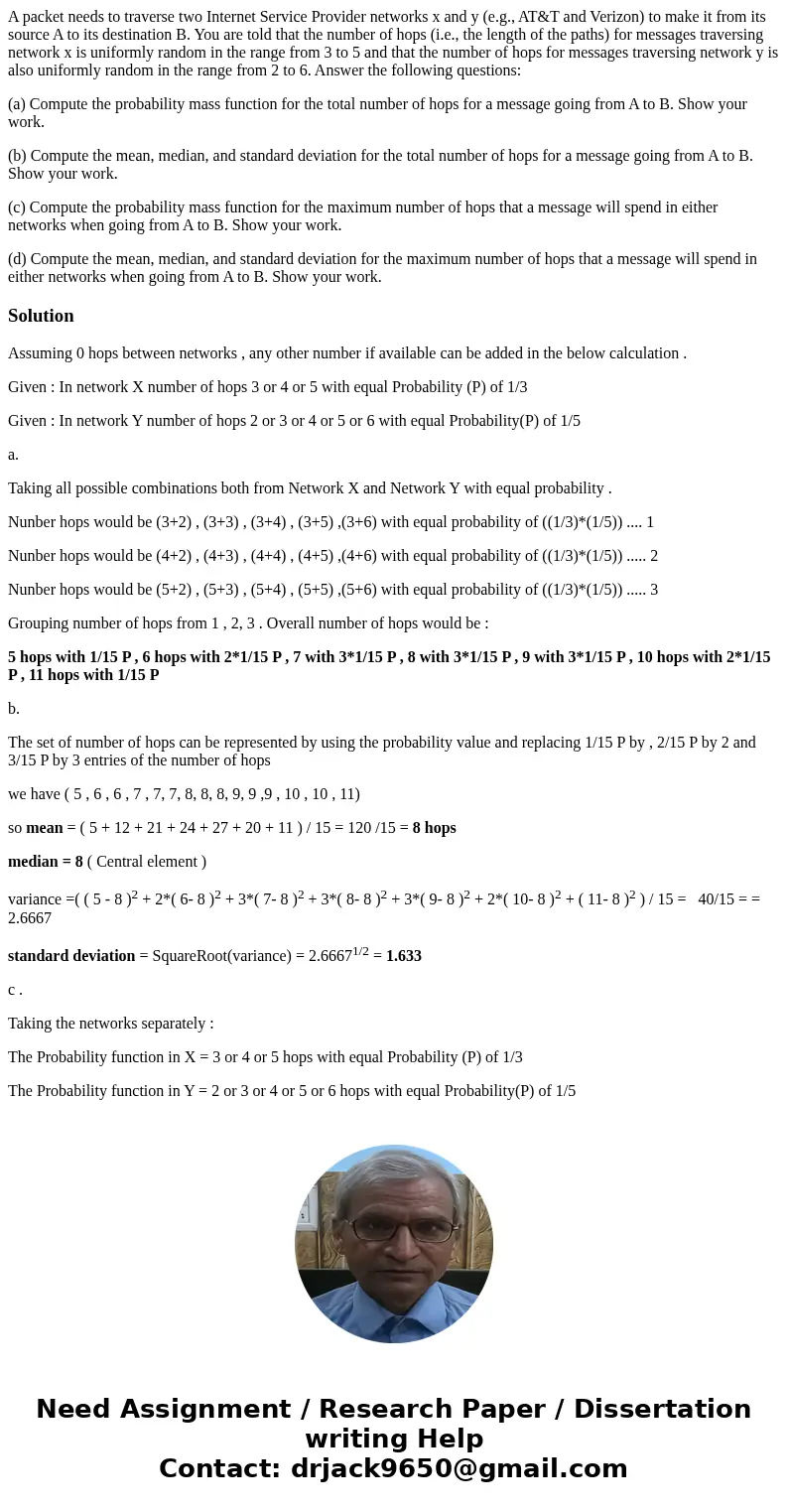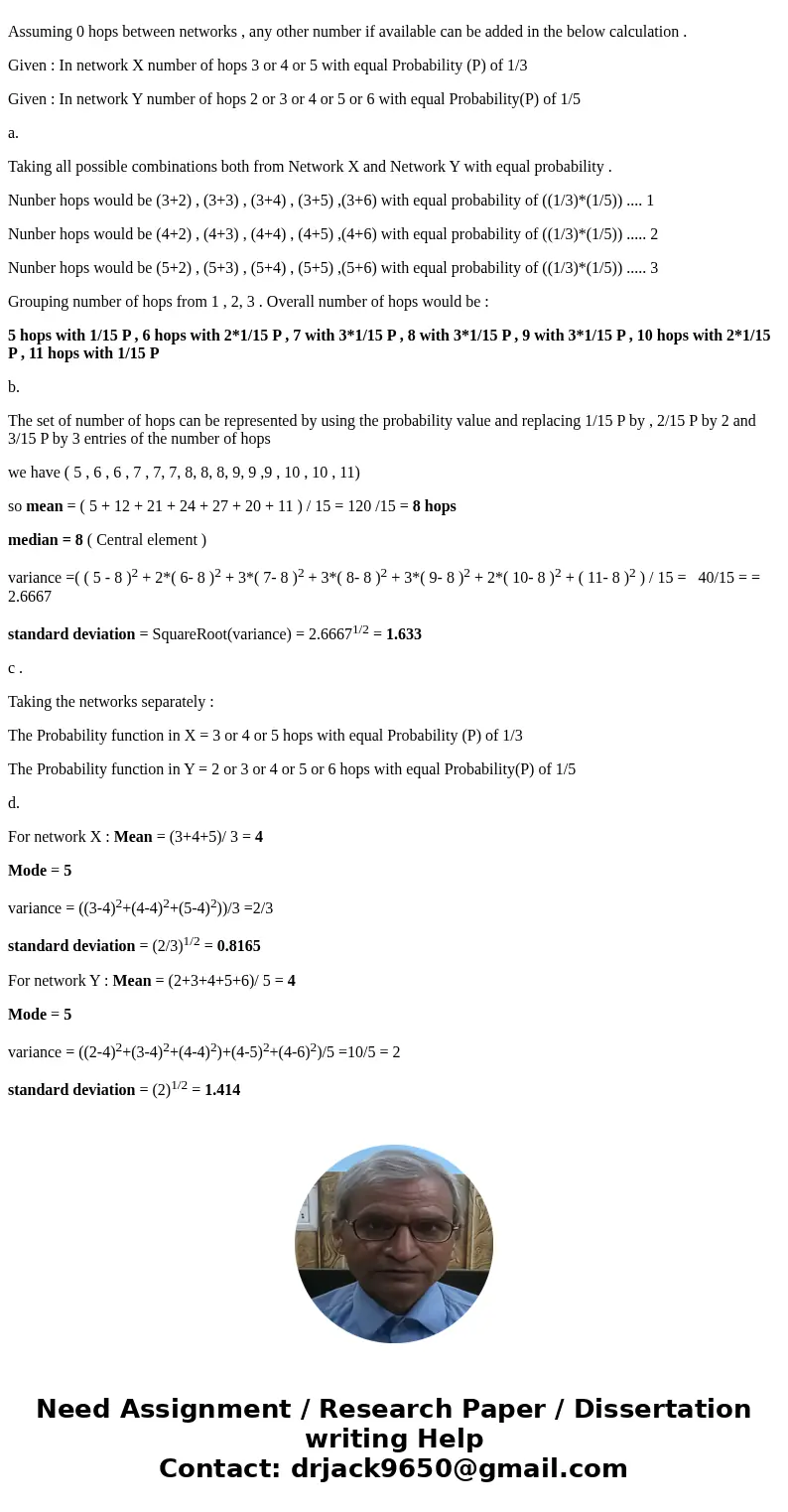A packet needs to traverse two Internet Service Provider net
A packet needs to traverse two Internet Service Provider networks x and y (e.g., AT&T and Verizon) to make it from its source A to its destination B. You are told that the number of hops (i.e., the length of the paths) for messages traversing network x is uniformly random in the range from 3 to 5 and that the number of hops for messages traversing network y is also uniformly random in the range from 2 to 6. Answer the following questions:
(a) Compute the probability mass function for the total number of hops for a message going from A to B. Show your work.
(b) Compute the mean, median, and standard deviation for the total number of hops for a message going from A to B. Show your work.
(c) Compute the probability mass function for the maximum number of hops that a message will spend in either networks when going from A to B. Show your work.
(d) Compute the mean, median, and standard deviation for the maximum number of hops that a message will spend in either networks when going from A to B. Show your work.
Solution
Assuming 0 hops between networks , any other number if available can be added in the below calculation .
Given : In network X number of hops 3 or 4 or 5 with equal Probability (P) of 1/3
Given : In network Y number of hops 2 or 3 or 4 or 5 or 6 with equal Probability(P) of 1/5
a.
Taking all possible combinations both from Network X and Network Y with equal probability .
Nunber hops would be (3+2) , (3+3) , (3+4) , (3+5) ,(3+6) with equal probability of ((1/3)*(1/5)) .... 1
Nunber hops would be (4+2) , (4+3) , (4+4) , (4+5) ,(4+6) with equal probability of ((1/3)*(1/5)) ..... 2
Nunber hops would be (5+2) , (5+3) , (5+4) , (5+5) ,(5+6) with equal probability of ((1/3)*(1/5)) ..... 3
Grouping number of hops from 1 , 2, 3 . Overall number of hops would be :
5 hops with 1/15 P , 6 hops with 2*1/15 P , 7 with 3*1/15 P , 8 with 3*1/15 P , 9 with 3*1/15 P , 10 hops with 2*1/15 P , 11 hops with 1/15 P
b.
The set of number of hops can be represented by using the probability value and replacing 1/15 P by , 2/15 P by 2 and 3/15 P by 3 entries of the number of hops
we have ( 5 , 6 , 6 , 7 , 7, 7, 8, 8, 8, 9, 9 ,9 , 10 , 10 , 11)
so mean = ( 5 + 12 + 21 + 24 + 27 + 20 + 11 ) / 15 = 120 /15 = 8 hops
median = 8 ( Central element )
variance =( ( 5 - 8 )2 + 2*( 6- 8 )2 + 3*( 7- 8 )2 + 3*( 8- 8 )2 + 3*( 9- 8 )2 + 2*( 10- 8 )2 + ( 11- 8 )2 ) / 15 = 40/15 = = 2.6667
standard deviation = SquareRoot(variance) = 2.66671/2 = 1.633
c .
Taking the networks separately :
The Probability function in X = 3 or 4 or 5 hops with equal Probability (P) of 1/3
The Probability function in Y = 2 or 3 or 4 or 5 or 6 hops with equal Probability(P) of 1/5
d.
For network X : Mean = (3+4+5)/ 3 = 4
Mode = 5
variance = ((3-4)2+(4-4)2+(5-4)2))/3 =2/3
standard deviation = (2/3)1/2 = 0.8165
For network Y : Mean = (2+3+4+5+6)/ 5 = 4
Mode = 5
variance = ((2-4)2+(3-4)2+(4-4)2)+(4-5)2+(4-6)2)/5 =10/5 = 2
standard deviation = (2)1/2 = 1.414


 Homework Sourse
Homework Sourse